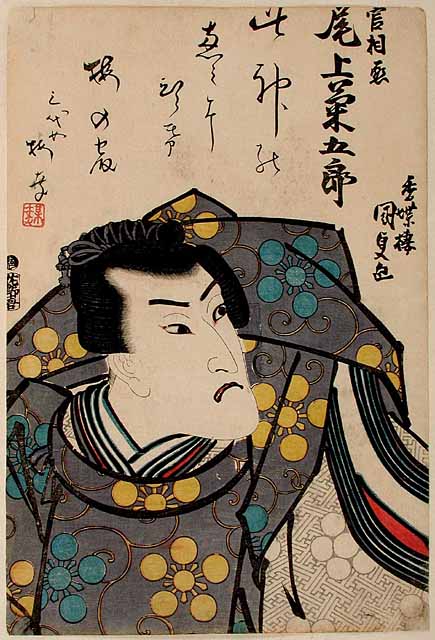
Onoe Kikugoro III as Kan Shojo in Sugawara denju tenarai kagami (Sugawara and the secrets of calligraphy) performed at the Nakamura Theatre in 11/1835
Private collection

Onoe Kikugoro III as Yuranosuke (right) and Mimasu Gennosuke III as Teraoka Heiemon (left) in Chushingura (The Treasury of loyal retainers) performed at the Nakamura Theatre in 07/1825 Kunisada 1 Private collection
In Act VII of this famous play about the revenge of the forty-seven samurai, the leader of the band, Yuranosuke, is found playing the profligate in a brothel in order to deceive his enemy’s spies. In the scene depicted here, Heiemon, a foot soldier in the service of their deceased master, approaches Yuranosuke and asks to be allowed to join in his plot against the powerful courtier who was responsible for their master’s downfall. Yuranosuke denies the existence of any such plot and claims he is under no obligation to avenge their master’s disgrace and death. Heiemon remonstrates with him but Yuranosuke pretends to fall asleep. Their dialogue is inscribed on the print. Yuranosuke eventually led his fellow samurai against their common enemy and they succeeded in killing him. They all then committed suicide.
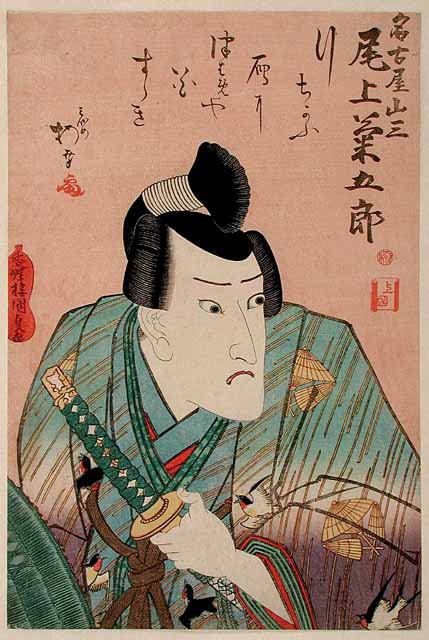
Onoe Kikugoro III as Nagoya Sanza in Nagoya obi kumo ni inazuma (A Nagoya rope sash and robes with lightning bolts amidst clouds) performed at the Morita Theatre in 09/1836
Kunisada 10
Private Collection
Ichikawa Ebizo V (formerly Danjuro VII) as Fuwa Banzaemon (right) and Onoe Kikugoro III as Nagoya Sanza (left) in Nagoya obi kumo ni inazuma (A Nagoya rope sash and robes with lightning bolts amidst clouds) performed at the Morita Theatre in 09/1836
Private collection
This pair of portraits commemorates a revival (with a different name) of the play that brought Danjuro VII (now acting as Ebizo V) and Kikugoro III together in these highly successful roles. The well-known rivalry between the two actors added spice to their confrontation in this famous ‘Scabbards clashing’ (Saya-ate) scene in the third act, which had featured in prints associated with earlier productions. Fuwa Banzaemon carries a sword named ‘Thunder’ and wears a kimono decorated with a pattern of ‘lightning-in-the-clouds’. His rival Nagoya Sanza carries a sword named ‘Amorous Swallows’ and wears a kimono with a ‘swallows-in-the-rain’ pattern tied with a sash of knitted rope. Unaware of each other, they make simultaneous entrances boasting of their fame, along the two raised passageways (hanamichi) that run through the audience to the main stage. As they pass on the main stage, which represents Nakano Street in the Yoshiwara pleasure district at cherry blossom time, their sword hilts clash. They exchange insults, remove their green sedge travelling-hats, recognize one another and draw swords to fight over the courtesan Katsuragi, whom they both love.
Above the actors’ heads are hokku poems (haiku) written by the actors themselves. Danjuro’s poem is signed with his poetry name Hakuen. It alludes to his repeated appearances in this role and to the lightning-in-the-clouds pattern on his robe, as well as to the date of this performance in the ninth month.
Bolts of lightning Inazuma mo appear countless times kazu o kasanete_in the ninth month! _kugatsu kana.
Kikugoro’s poem is signed with his poetry name Baiko. As well as alluding to the swallows-in the-rain pattern on his robes, the poem suggests a comparison between the action in this scene when the actors pass each other on stage, and geese and swallows flying past each other as one arrives and the other departs in the autumn, the season of this performance:
Passing by each other Yuki-chigau_wild geese and swallows _kari ni tsubame ya_over ripened pampas grass. _hanasusuki.
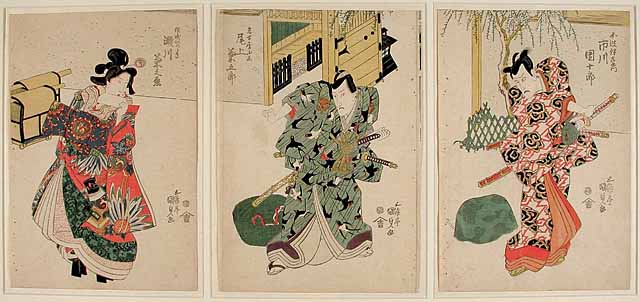
Ichikawa Danjuro VII as Fuwa Banzaemon (right), Onoe Kikugoro III as Nagoya Sanza (centre) and Segawa Kikunojo V as the courtesan Katsuragi (left) in Ukiyo-zuka hiyoku no inazuma (Ukiyo’s sword hilt, a double grave mound and the mark of the lightning bolt) performed at the Ichimura theatre in 03/1823
Kunisada 2
Private collection
This famous Saya-ate (‘Scabbards clashing’) confrontation scene occurs in the third act of the play, which was written for these performers and first performed in this production in 1823. The idea derived both from the established Kabuki convention of a Saya-ate scene, and from the 1807 novel by Santo Kyoden, Mukashi banashi inazuma hyoshi (An Old Time Lightning Bolt Tale). Fuwa Banzaemon carries a sword named ‘Thunder’ and wears a kimono decorated with a pattern of ‘lightning-in-the-clouds’. His rival Nagoya Sanzaburo (Sanza for short) carries a sword named ‘Amorous Swallows’ and wears a kimono decorated with a ‘swallows-in-the-rain’ pattern. Unaware of each other, they make simultaneous entrances along the two raised passageways (hanamichi) through the audience. As they pass on the main stage (which represents Nakano Street in the Yoshiwara pleasure district at cherry blossom time), their sword hilts clash. They exchange insults, remove their green sedge travelling-hats, recognize one another and draw swords to fight over the courtesan Katsuragi. Katsuragi rushes forward and persuades them to call a truce.

Kawarazaki Gonjuro Yaegaki Monza kawara nadeshiko (Kawarazaki Gonjuro I as Yaegaki Monza: Wild Pink)
1862
Given by the Friends of the Fitzwilliam with the aid of the MGC Purchase Grant Fund and the National Art Collections Fund (P.88-1999)
From the series Tosei mitate sanju-rokkasen (Comparison of roles with the thirty-six flowers at their zenith).
Collections Record: P.55-1999
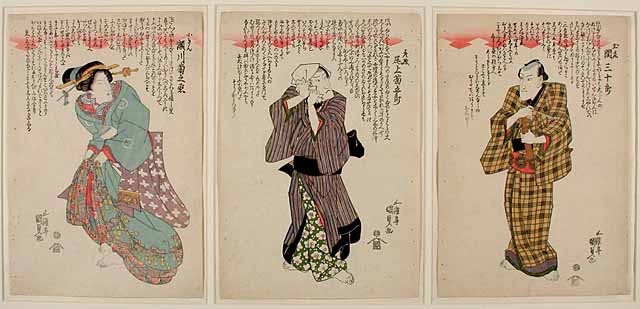
Seki Sanjuro as Tamasho (right), Onoe Kikugoro III as Hikoso (centre) and Segawa Kikunojo V as Kokin (left), in Hana-gumori sato no geta-kasa (Clogs and umbrellas in Yoshiwara on a cloudy day amidst cherry blossoms) performed at the Nakamura Theatre in 03/1824
Kunisada 0
Private collection (565)
This triptych captures the interplay between the three characters at a climactic moment in the play. The text around them records their dialogue in the scene, revealing that the geisha Kokin and her lover Hikoso are making their escape from the licensed quarters. Tamasho tries to dissuade couple from taking such a tragic course of action. In the mid 1820s there was a brief vogue for filling the background of half-length and full-figure actor portraits with extended texts (see also the diptych included in this exhibition). This device was derived from inexpensive, illustrated popular novels, in which text filled all the space around the figures. Kunisada was an experienced illustrator of such novels and often drew the characters with actors’ features. )
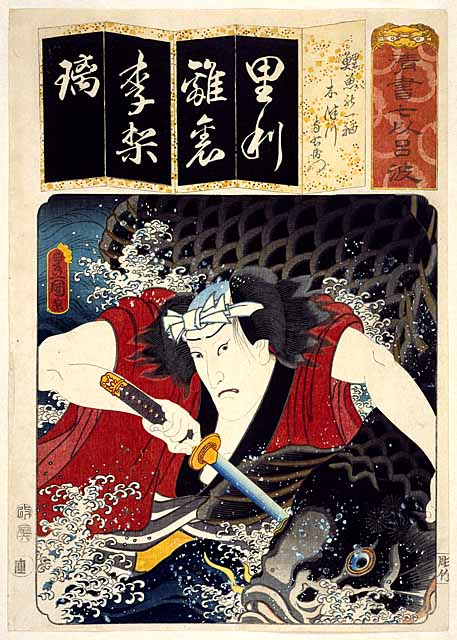
Ri (Ri)
06/1856
Given by the Friends of the Fitzwilliam with the aid of the MGC Purchase Grant Fund and the National Art Collections Fund.
A posthumous portrait of Onoe Baiju (a name used by Onoe Kikugoro III in retirement) as Rokusaburo the carpenter with a giant carp, from the series Kiyogaki nanatsu iroha (Neatly Written Syllabary in the Seven Styles). On the folding screen at the top the character for the syllable ‘Ri’ is written out in four different ways with different meanings, and also appears in a poem by Kizugawa Yoemon; one of the possible meanings is ‘carp’.
Rokusaburo is the main character in the play Mijikayo ukina no chirashigaki, set in the timber yards of Fukugawa. The scene depicted is a ‘carp-grappling scene’ (koitsukami), which originated in the type of summer play (natsu kyogen) known as mizu kyogen (‘water play’), using tanks of real water (honmizu) on stage. Plays with carp-grappling scenes (koitsukami mono) involved the hero in underwater combat with the spirit of a giant carp (an elaborate prop). The technique was passed down through the Onoe lineage of actors to Kikugoro III, who made the scene famous in Kijikayo ukina no chirashigaki when it was premiered in 1813 and commemorated in an earlier print by Kunisada. In this print, the spray is achieved by splashing the surface with white pigment.
Collections Record: P.71-1999



